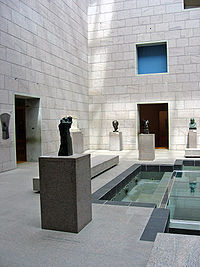
Cultural policy is the government actions, laws and programs that regulate, protect, encourage and financially (or otherwise) support activities related to the arts and creative sectors, such as painting, sculpture, music, dance, literature, and filmmaking, among others and culture, which may involve activities related to language, heritage and diversity. The idea of cultural policy was developed at UNESCO in the 1960s. Generally, this involves governments setting in place processes, legal classifications, regulations, legislation and institutions (e.g., galleries, museums, libraries, opera houses, etc.) which promote and facilitate cultural diversity and creative expressions in a range of art forms and creative activities. Cultural policies vary from one country to another, but generally they aim to improve the accessibility of arts and creative activities to citizens and promote the artistic, musical, ethnic, sociolinguistic, literary and other expressions of all people in a country. In some countries, especially since the 1970s, there is an emphasis on supporting the culture of Indigenous peoples and marginalized communities and ensuring that cultural industries (e.g., filmmaking or TV production) are representative of a country's diverse cultural heritage and ethnic and linguistic demographics.
Cultural policy can be done at a nation-state level, at a sub-national level (e.g., U.S. states or Canadian provinces), at a regional level or at a municipal level (e.g., a city government creating a museum or arts centre). Examples of cultural policy-making at the nation-state level could include anything from funding music education or theatre programs at little to no cost, to hosting corporate-sponsored art exhibitions in a government museum, to establishing legal codes (such as the U.S. Internal Revenue Service's 501(c)(3) tax designation for not-for-profit enterprises) and creating political institutions (such as the various ministries of culture and departments of culture and the National Endowment for the Humanities and the National Endowment for the Arts in the United States), arts granting councils, and cultural institutions such as galleries and museums. Similar significant organisations in the United Kingdom include the Department for Culture, Media and Sport (DCMS), and Arts Council England.
Throughout much of the twentieth century, many of the activities that compose cultural policy in the 2010s were governed under the title of "arts policy". Arts policy includes direct funding to artists, creators and art institutions and indirect funding to artists and arts institutions through the tax system (e.g., by making donations to arts charities tax-deductible). However, as Kevin Mulcahy has observed, "cultural policy encompasses a much broader array of activities than were addressed under arts policy. Whereas arts policy was effectively limited to addressing aesthetic concerns (e.g., funding art galleries and opera houses), the significance of the transformation to cultural policy can be observed in its demonstrable emphases on cultural identity, valorization of indigineity [Indigenous people's culture] and analyses of historical dynamics (such as hegemony and colonialism)."[1] A general trend in Western industrialized nations is a shift, since the 1970s and 1980s, away from solely supporting a small number of relatively elite, professionalized art forms and institutions (e.g., Classical music, painting, sculpture, art galleries) to also supporting amateur and community cultural and creative activities (e.g., community theatre) and cultural forms which were not considered part of the Western canon by previous generations (e.g., traditional music such as blues, World music, and so on).
- ^ Mulcahy, Kevin V. 2006. "What is Cultural Policy?"